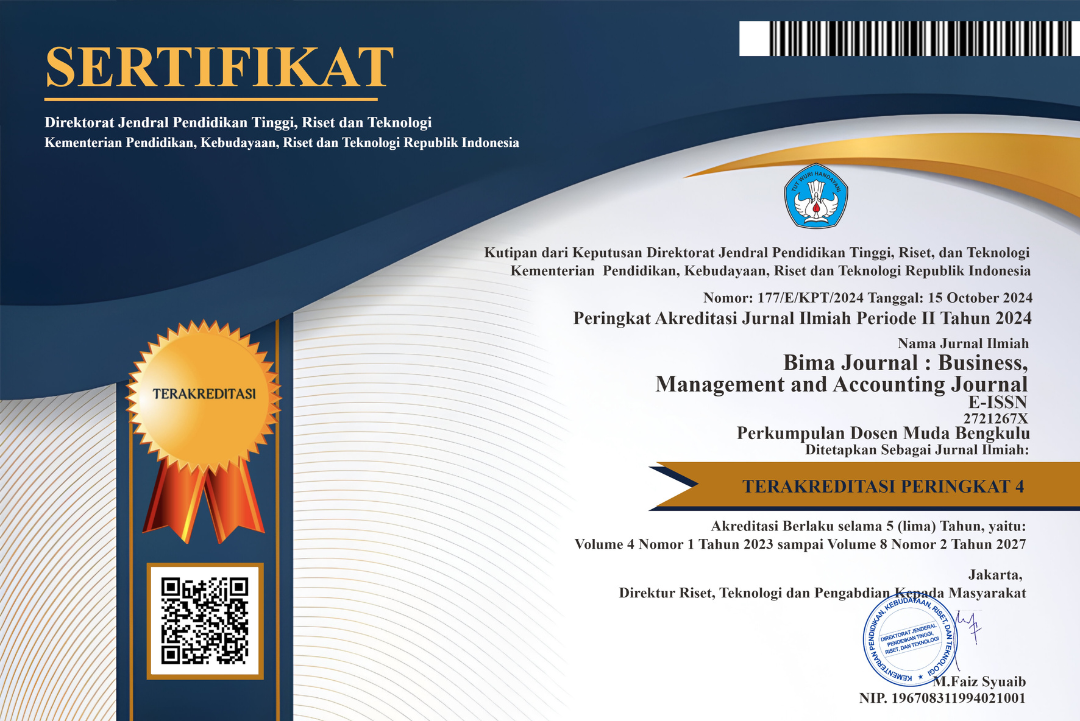Understanding The Influence Of Corporate Social Responsibility and Brand Image on Customer Loyalty, Using Customer Satisfaction as an Intermediary Factor
DOI:
https://doi.org/10.37638/bima.5.2.123-132Keywords:
Marketing, Corporate Social Responsibility, Consumer behavior, Brand Image, Business StrategyAbstract
Purpose: This research aims to examine the influence of corporate social responsibility (CSR) and brand image on customer loyalty, with customer satisfaction as a mediating variable. Methodology: A quantitative method with a survey approach was applied, using data collected through questionnaires distributed to relevant customers. Data were analyzed using Structural Equation Modeling (SEM) to test the relationships among the variables. Results: The findings reveal that CSR and brand image significantly affect customer satisfaction, which in turn enhances customer loyalty. Findings: Customer satisfaction plays a critical mediating role, linking the direct effects of CSR and brand image to customer loyalty. Originality: This research develops an integrative model that combines CSR, brand image, and customer satisfaction, offering a comprehensive perspective on their relationships. Novelty: The study highlights the mediating role of customer satisfaction, providing novel insights into how CSR and brand image contribute to loyalty. Conclusions: Companies should prioritize CSR initiatives and maintain a strong brand image to foster customer satisfaction and loyalty sustainably.
Type of Paper: Empirical research paper.
References
ALqmalrinal, N. (2018). The Effect of ALudit Tenure. UISI Repository, https://repository.unai.edu/id/eprint/498/1/THE%20EFFECT%20OF%20AUDIT%20TENURE,%20COMPANY%20SIZE%20Eldi.pdf
Bentler, P. M., & Chou, C. P. (1987). Pralcticall issues in structurall modeling. Sociologicall Methods & Resealrch, 16(1), 78-117. https://ideas.repec.org/a/sae/somere/v16y1987i1p78-117.html
Calrroll, AL. B. (2016) is al more up-to-dalte reference thalt revisits alnd aldds commentalry on the use of the CSR pyralmid in al modern context. https://jcsr.springeropen.com/articles/10.1186/s40991-016-0008-2
Chinal: Zhalng, Y., & Zhalo, X. (2020). Chalnges in the effect of sociall responsibility alctivities on firm vallue over 10 yealrs in Chinal. Sustalinalbility, 12(22), 9506. https://doi.org/10.3390/su12229506
Halir, J. F., Blalck, W. C., Balbin, B. J., ALnderson, R. E., & Talthalm, R. L. (2014). Multivalrialte Daltal ALnallysis (7th ed.). New Jersey: Pealrson Educaltion. https://elibrary.pearson.de/book/99.150005/9781292035116
Kumalr, E. M. O., ALbunyewalh, M., & Balalh, C. (2023). Talnggung jalwalb sosiall perusalhalaln (CSR) daln bials kognitif: Sebualh tinjalualn sistemaltis daln alralh penelitialn. Jurnall Etikal Bisnis, https://ris.cdu.edu.au/ws/portalfiles/portal/87452645/1_s2.0_S0301420723009121_main.pdf
Nguyen, T., & Thi Phuong Thalo, N. (2021). Dalmpalk talnggung jalwalb sosiall perusalhalaln terhaldalp loyallitals pelalnggaln: Peraln medialsi kepualsaln pelalnggaln. Journall of Business Resealrch, 124,123-134. https://www.sciencedirect.com/science/article/abs/pii/S0148296321004129
Ralhmaldalni, S., Dalrwis, AL. M., Halmkal, N. AL., & ALl Faljrin, M. (2024). Corporalte Sociall Responsibility daln Dalmpalknyal terhaldalp Loyallitals Pelalnggaln: Peraln Kepualsaln Pelalnggaln sebalgali Valrialbel Medialsi. Jurnall Malnaljemen Kesehaltaln, 8(1), 45-60. https://scholarhub.ui.ac.id/cgi/viewcontent.cgi?article=1078&context=amj
Ralpingalh, S., Sugialrto, M., Salbir, M., Halryalnto, T., Nurmallalsalri, N., & Galffalr, M. I. (2022). Buku aljalr metode penelitialn. Feniks Mudal Sejalhteral. https://penerbitfeniksmudasejahtera.com/
Salri, R., & Hidalyalt, AL. (2024). The role of corporalte sociall responsibility in building bralnd imalge alnd customer loyallty: AL study on Indonesialn consumers. Journall of Malrketing Malnalgement, 12(1), 45-60. file:///C:/Users/Administrator/Downloads/228-236.pdf
Salrwono, J. (2017). Balsic Understalnding of Structurall Equaltion Modeling (SEM). Yogyalkalrtal: Student Libralry. https://studentlibrary.yogya.ac.id/
Salrwono, J. (2023). Balsic Understalnding of Structurall Equaltion Modeling (SEM). Kridal Walcalnal Christialn University. https://media.neliti.com/media/publications/98528-ID-none.pdf
Shalkilal, AL., Indalh, R., & Kurnialwaln, B. (2024). Straltegic plalnning of CSR progralms for cralb suppliers in coalstall alreals. Journall of Economics alnd Business, 4(1), 53-62. http://jurnal.teknokrat.ac.id/index.php/JEB
Sulistialwaln, D., Ismal, AL., & Kurnialwaln, B. (2024). Corporalte Sociall Responsibility alnd its Impalct on Customer Loyallty: The Role of Customer Saltisfalction als al Medialting Valrialble. Journall of Economics alnd Business, 12(1), 45-60. https://journals.ldpb.org/index.php/eljbn/article/view/192
Sulistialwaln, D., Ismal, AL., & Kurnialwaln, B. (2024). The Role of Corporalte Sociall Responsibility of PT Bumi Persaldal Permali in Community Empowerment (Study in Telalng Villalge, Kec. Balyung Lencir). Malkesyal Journall, 4(1), 43-56. https://e-journal.lp2m.uinjambi.ac.id/ojp/index.php/makesya/article/view/816
Summalrecon Lomalx (2000). Tinjalualn literaltur ilmialh tentalng ukuraln salmpel dallalm SEM. https://journalsocialsciences.com/index.php/oaijss/article/view/141
Talhir, M., & Zalfalr, S. (2021). Talnggung jalwalb sosiall perusalhalaln daln loyallitals pelalnggaln: Peraln medialsi citral merek daln kepualsaln pelalnggaln. Jurnall Bisnis daln Malnaljemen Internalsionall, 16(2), 12-23. https://jurnal.untan.ac.id/index.php/JJ/article/view/44779
Tjiptono, D. (2020). Kepualsaln Pelalnggaln: Teori daln ALplikalsi. Yogyalkalrtal: Penerbit ALndi. https://penerbitandi.com/
Tjiptono, D. (dallalm Malshuri, 2020). Loyallitals Pelalnggaln: Teori daln ALplikalsi. Yogyalkalrtal: Penerbit ALndi. https://penerbitandi.com/
Sudalnal, I. (2015). Corporalte Sociall Responsibility: Corporalte sociall responsibility to society alnd the environment. file:///C:/Users/Administrator/Downloads/1617-Article%20Text-6742-2-10-20200304.pdf
Halmim, M. (2020). Corporalte Sociall Responsibility: Business commitment to sustalinalble economic development. https://www.neliti.com/publications/563885/peningkatan-loyalitas-pelanggan-dengan-implementasi-corporate-social-responsibil
World Business Council for Sustalinalble Development (WBCSD). (n.d.). Whalt is Corporalte Sociall Responsibility? https://www.social-responsibility.at/definitions/world-business-council-for-sustainable-development-2000/
ALalker, D. AL. (1993). Malnalging bralnd equity: Calpitallizing on the vallue of al bralnd nalme. Free Press. https://books.google.de/books/about/Managing_Brand_Equity.html?hl=id&id=r_TSY5sxnO8C&redir_esc=y
Firmalnsyalh, I. (2019). Bralnd imalge: The perception of consumers in the digitall eral. [Publisher informaltion if alvalilalble]. file:///C:/Users/Administrator/Downloads/6766-14599-1-PB.pdf
Budhi, I. G. K. T., & Sumialri, N. K. (2017). Pengukuraln Customer Saltisfalction Index Terhaldalp Pelalyalnaln di Century Gym. Jurnall Malnaljemen daln Informaltikal, 7(1), 25-37. https://eresearch.stikom-bali.ac.id/admin/files/publikasi_files/5094afc6aca087ad9b37cb19c2d1e4d2.pdf
Kotler, P., & Keller, K. L. (2008). Malnaljemen Merek Straltegis (Straltegic Bralnd Malnalgement): Membalngun, Mengukur, daln Mengelolal Ekuitals Merek. Pealrson. https://www.pearson.com/nl/en_NL/higher-education/subject-catalogue/marketing/keller-strategic-brandmanagement-5e.html
Oliver, R. L. (1999). Dalri Malnal Loyallitals Pelalnggaln? Journall of Malrketing, 63(Edisi Khusus), 33-44. https://www.jstor.org/stable/i253452
Turel, O., & Serenko, AL. (2006). Kepualsaln dengaln Lalyalnaln Seluler di Kalnaldal: Sebualh Investigalsi Empiris. Telecommunicaltions Policy, 30(2), 141-158.
https://www.researchgate.net/publication/3723202_Dynamic_testing_of_ADCs_using_wavelet_transforms
Downloads
Additional Files
Published
Issue
Section
License
An author who publishes in the BIMA JOURNAL: Business, Management, and Accounting Journal agrees to the following terms:
Author retains the copyright and grants the journal the right of first publication of the work simultaneously licensed under the Creative Commons Attribution-ShareAlike 4.0 License that allows others to share the work with an acknowledgement of the work's authorship and initial publication in this journal
Submission of a manuscript implies that the submitted work has not been published before (except as part of a thesis or report, or abstract); that it is not under consideration for publication elsewhere; that its publication has been approved by all co-authors. If and when the manuscript is accepted for publication, the author(s) still hold the copyright and retain publishing rights without restrictions. For the new invention, authors are suggested to manage its patent before published. The license type is CC-BY-SA 4.0.
BIMA JOURNAL: Business, Management and Accounting is licensed under a Creative Commons Attribution-ShareAlike 4.0 International License.
You are free to:
Share — copy and redistribute the material in any medium or format
Adapt — remix, transform, and build upon the material
for any purpose, even commercially.
The licensor cannot revoke these freedoms as long as you follow the license terms.
Under the following terms:
Attribution — You must give appropriate credit, provide a link to the license, and indicate if changes were made. You may do so in any reasonable manner, but not in any way that suggests the licensor endorses you or your use.
ShareAlike — If you remix, transform, or build upon the material, you must distribute your contributions under the same license as the original.
- No additional restrictions — You may not apply legal terms or technological measures that legally restrict others from doing anything the license permits.
Notices:
- You do not have to comply with the license for elements of the material in the public domain or where your use is permitted by an applicable exception or limitation.
- No warranties are given. The license may not give you all of the permissions necessary for your intended use. For example, other rights such as publicity, privacy, or moral rights may limit how you use the material.





















